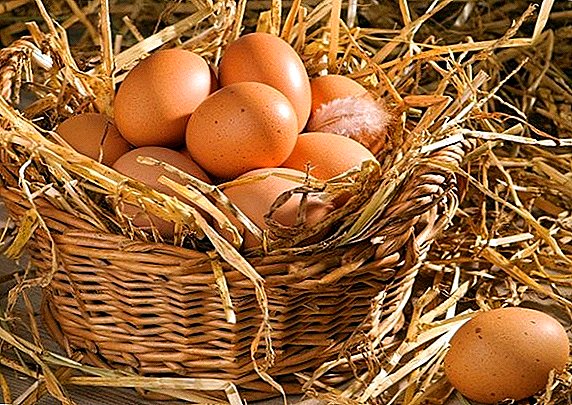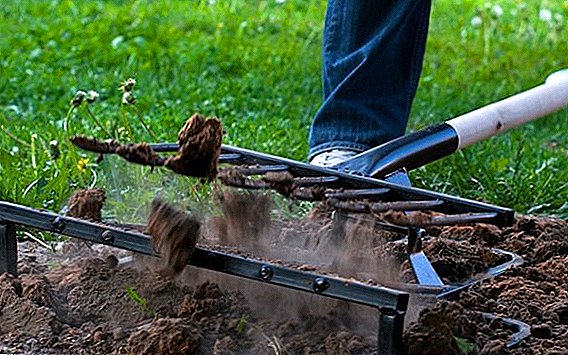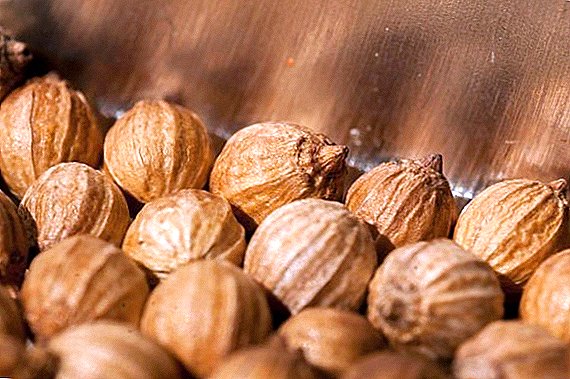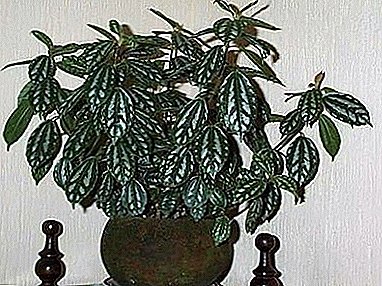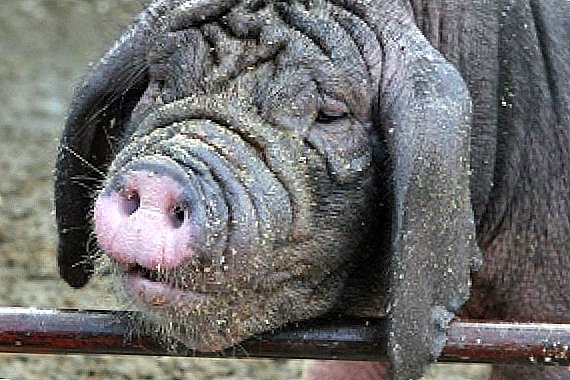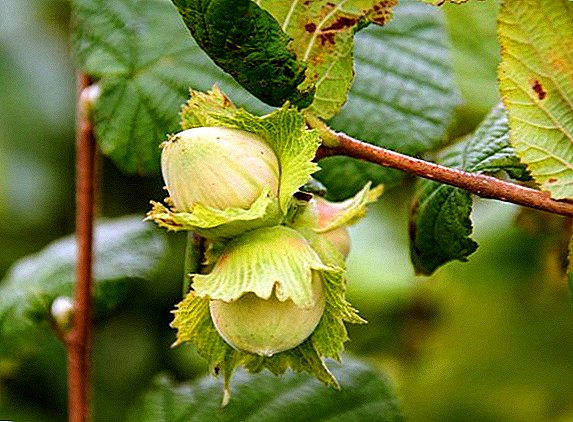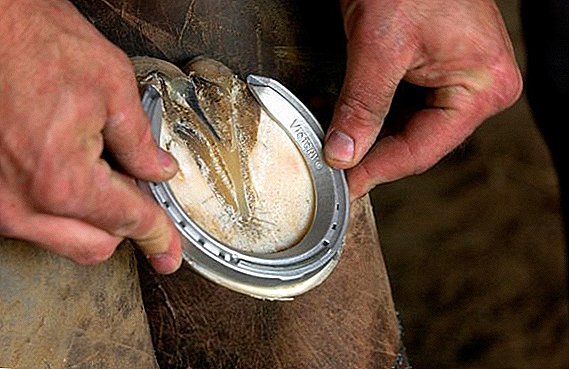 Horseshoes help protect the horse’s hooves. With the wrong shoeing, you can not only damage the hoof, but also provoke an infection of the extremities.
Horseshoes help protect the horse’s hooves. With the wrong shoeing, you can not only damage the hoof, but also provoke an infection of the extremities.
In this article we will take a closer look at why horses need to be shod, and we will also deal with the main intricacies of this procedure.
Why horses need horseshoes
Under natural conditions, horses inhabit the steppe, moving on soft soil. This contributes to the natural erasure of the corneous parts of the feet, in which the regeneration processes are equal to or exceed the activity of grinding.
The horse's body regains keratinous integument before it is completely erased. In private breeding, horses often live and develop in the conditions of areas with a rough road surface, which accelerates hoof wear several times. 
Horseshoe is the easiest and most effective means of protecting the hoof. It helps prevent over-erasing of the keratinous layer of the extremities and protect the feet of the equine from mechanical and infectious lesions.
Did you know? The ancient Gauls began to shoe horses first, approximately in the III-IV century BC. erIn addition, horseshoes often have on their surface a variety of bumps or spikes - this makes it possible to improve the adhesion of the hooves to the road surface. As a result, the animal feels more confident when moving, which is especially important in winter.
But there is this accessory and contraindications: with free keeping in pens with grazing in open meadows it is not recommended to shoe horses. In this case, the animals are practically not in contact with asphalt or concrete pavement, which allows the body to provide natural protection against damage to the feet.  In addition, in free-range horses, they often play with each other, and savvy individuals can damage both their relative and themselves.
In addition, in free-range horses, they often play with each other, and savvy individuals can damage both their relative and themselves.
Did you know? Metal horseshoes were first used by the ancient Romans in the I century BC. er They represented a small plate with various hooks, bows, rings, etc., which were fastened with the help of small ropes or leather straps.
Types of horseshoes for horses
Today, horse-breeding provides for the division of horseshoes into several types, depending on the goals and objectives in which the horse will take an active part. Consider further the main features of each of them in order.
Standard (simple)
Standard models are used in most horse farms for everyday use. They are made of metal, have an oval shape and often weigh about 300 g.  Additionally, standard horseshoes can be equipped with spikes to prevent the horse from sliding on a smooth surface. Such an accessory is chosen strictly according to the size of the hoof.
Additionally, standard horseshoes can be equipped with spikes to prevent the horse from sliding on a smooth surface. Such an accessory is chosen strictly according to the size of the hoof.
Similar models are used for both young and mature individuals, regardless of the purpose of use. The special structure and anti-skid spikes make it possible to use standard models in any weather and for any economic purposes, which made them the most popular in the world.
Learn how to care for horses hooves.
Sports
Such models are used for the maintenance of sports horses, when the animal is actively training every day or preparing for the next competition. They have an oval shape, but they differ from the standard ones by palpable lightness.
Their main feature is high wear resistance, as well as improved adhesion to surfaces, which, thanks to the anatomical shape, helps not to hinder the movement of animals.  Sports models are strictly distributed regarding sports, the characteristics of the participating animals and the conditions in which they will be used:
Sports models are strictly distributed regarding sports, the characteristics of the participating animals and the conditions in which they will be used:
- race horses fix lightweight taps with a mass not exceeding 150 g. These models are made of durable and lightweight materials that have the effect of "spring". For use on ice or in winter, there are anti-slip models with a special trapezoidal section;
- when a horse participates in all-around, it is shod with coal horseshoes with a 10 mm rim on the bottom, weighing about 150 g. If all-around is held in winter, a rounded horseshoe weighing 180-200 g with three large spikes on the bottom or horseshoes Berezovets. They are distinguished from the rest by the absence of thorns and increased thickness;
- To participate in the show jumping (running to overcome obstacles) animals wear thin and lightweight horseshoes. At the same time, such an accessory must meet certain sporting standards - the thickness of the branches should not be larger than the horn of the wall, and the spikes must be bent inward;
Familiarize yourself with the types of horse gaits.
- participants of running types of competitions wear taps depending on the type of density of the coating over which they will race. It can be both thickened, Berezovets, and standard models weighing 300 g;
- for various equestrian games are often used coal horseshoes with a low rim. The absence of thorns is the main requirement of these competitions, as the horse during the game can hurt not only himself but also the person;
- for participation in dressage, shoeing is not used, but if necessary, forelimbs can be shod. For this purpose, lightweight models with a smooth surface are used;
- at winter competitions horses are put on coal outboards with numerous teeth on the outer rim. The main feature of such models is the presence of a smooth metal plate on the bottom, which prevents the snow from sticking to the extremities.

Lungs
Light models put on trotters, their main feature is the different weight between the rear and front horseshoes.
The rear ones are often 25-40% heavier than the front ones - this helps ease the movement of the horse when moving with a fast and steady trot, as well as protect it from the development of an amble. The weight of such models can be diverse, but in most cases does not exceed 180-210 g.
Did you know? Professional jumping came at the beginning of the 19th century in France, and the first competitions in this sport were held in the middle of the century.
The dimensions of the light horseshoes are always strictly observed: their thickness must be at least 4 mm, and the width at least 8 mm. Light horseshoes are often adults, as young trotters do not need a horseshoe.
In the future, for training at the racetrack, they wear training horseshoes of a rounded shape with a special jumper at the end of the branches. 
Orthopedic
Orthopedic models are used to:
- soften the progress of the equine;
- reduce discomfort or pain in the limbs caused by injuries or damage to the hoof;
- accelerate the healing of the injured limb;
- align the movement of the limb;
- reduce the load on the feet and limbs;
- to correct the deformed hoof.
Important! Only experienced veterinarian will be able to pick up and securely fix the horseshoe on the horse's limbs. Self-shoeing can aggravate the overall condition of the hoof, and even lead to an infectious lesion of the feet.
There are many varieties of orthopedic horseshoes on the market today. Among them, models for walking correction, as well as horseshoes-clamps, which help to fix a split or shattered hoof, are especially popular. 
How to choose a horseshoe for a horse
In order to choose the right horseshoe, you must:
- To decide for what purposes the horse will be used, what loads will act on the animal. After that, in accordance with the task, select the required type from those described above.
- Then you need to determine the desired size of the accessory. To do this, measure each hoof in length and width.
- The obtained measurements should be compared with a special table and identify the required size.
- Next, select the material of the accessory. Today there are steel, rubber and plastic horseshoes on the market. The most versatile are metal products made from lightweight alloys. They are suitable for almost any purpose, but if you need a particularly soft, horseshoe-free movement, you can consider rubberized or plastic.
- After the accomplished actions, you can proceed to the acquisition and installation of the accessory.
Familiarize yourself with the structure and diseases of the limbs of horses.
In addition, when choosing a horseshoe, it is necessary to take into account the season of the year. There are summer and winter models: the latter are often distinguished by spike inclusions, which in summer will not only impede the movement of an animal, but also significantly increase the load on its limbs.  Do not forget that horseshoes are divided into front and rear. Despite the fact that they visually do not differ from each other, they have a different contour that directly affects the quality and ease of movement of the area.
Do not forget that horseshoes are divided into front and rear. Despite the fact that they visually do not differ from each other, they have a different contour that directly affects the quality and ease of movement of the area.
Important! When choosing a horseshoe, be sure to carefully consider the size, since different manufacturers often label them differently.
How to shoe a horse
In order to efficiently shoe a horse, every horse breeder must have on the farm:
- a brush with medium-hard hair - with its help the hoof is cleaned from dirt, manure residues and other things;
- cut-off - for bending rivets of horseshoe nails;
- hoof hook - to remove frozen mud;
- hoof cutter - to remove the old cornea layer;
- hoof rasp - for polishing the hoof;
- hoofed mites - for removing rivets from horseshoes;
- anvil and forging hammer weighing at least 500 g - for leveling and fitting the size of a horseshoe.
 The main stages of horse training:
The main stages of horse training:- The first thing to do before the procedure is to tie the horse to a strong support. Forging often ends up in an animal with severe stress (especially for juvenile individuals), so the animal may sharply twitch and strike the host. Next, you need to wrap and fix the horse's limb so that you have free access to the entire hoof, while at the same time you should avoid unnatural bending of the joints. Otherwise, the animal may react very negatively to the procedure.
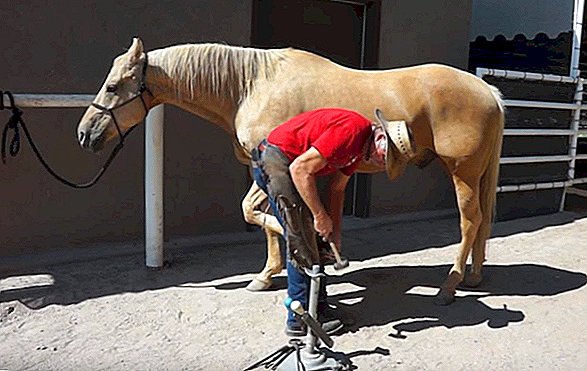
- If you are faced with the task of shoeing an adult horse, then before the procedure you need to remove the existing horseshoes. To do this, take the baffle, forging hammer and unbend the caps of the rivets, and then alternately pull them out of the hoof with tongs. If, after removing the rivets, the horseshoe does not disappear by itself, take it with the tongs by the edge and slightly pull it to the side.
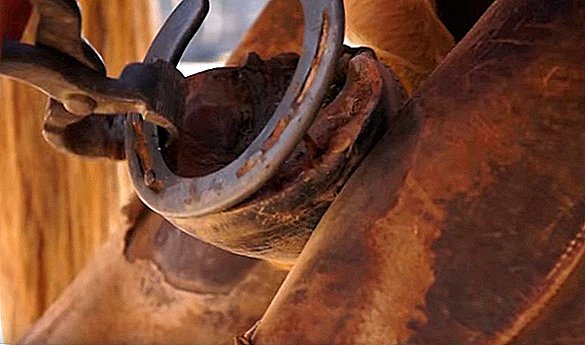
- No matter how good the shoeing is, the remnants of dirt and manure under the horseshoe can cause inflammation and infectious lesions of the hoof. Therefore, using a hoof hook and brush, it is necessary to remove all traces of dirt and thoroughly wash the horse's foot with soap and water. After the procedure, the soles are wiped dry.
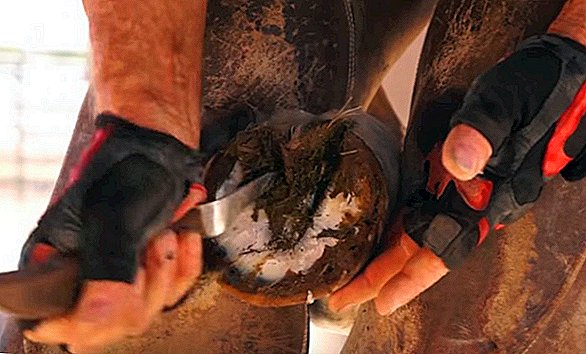
- The forging is carried out exclusively on a flat sole, the heel should ideally fit to the hoof, otherwise dirt and manure can clog in the cracks and cause inflammation of the horse's soles. To avoid this, you need to eliminate the irregularities and a variety of chipped hoof. This is done with an extremely sharp hoof digger, so you must be careful not to injure the animal. At this stage, the corneous layer of the feet is also shortened - the optimal length of the hoof is about 7 cm (from the hair growth zone). At the end of the procedure, the horse's foot is ground with a rasp.
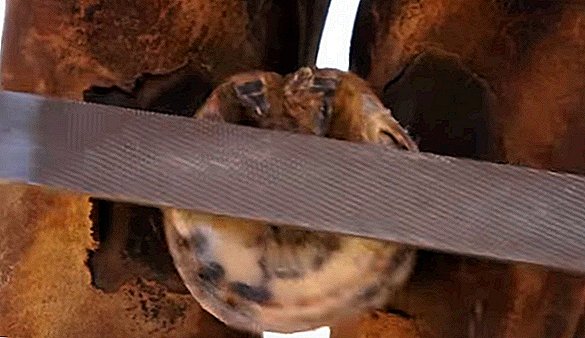
- When the horse is fully prepared, you can begin to determine the size of the future heel - for this, each hoof is measured in length and width, and then choose the desired size and type of future heels.
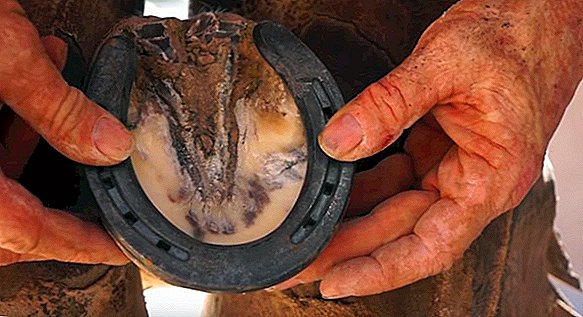
- Quite often a situation arises when a horseshoe does not have an ideal form. In this case, it is necessary to align it with respect to the shape of each hoof with the help of an anvil and forging hammer. A flat heel should touch the hoof without any gaps, and also repeat its contours completely.
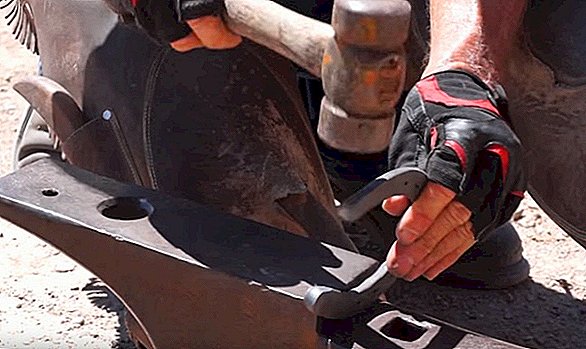
- When the horseshoe is fully prepared, it can be fixed on the hoof. The rivets in the foot are alternately hammered, using a forging hammer, and only into special holes in the horseshoe.
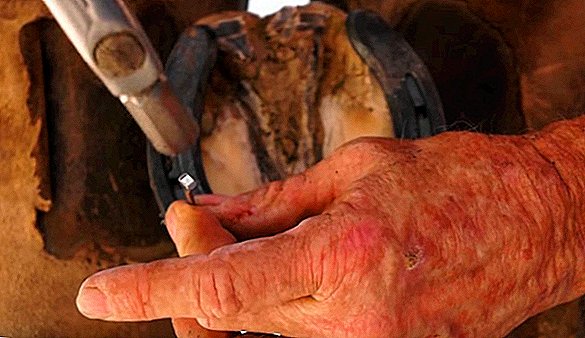 Rivets that have come out near the hoofed horn must be cut off.
Rivets that have come out near the hoofed horn must be cut off.  After that, they are placed under the tongs, and then pressed with a hammer in order to tighten the horseshoe to the sole. At the end all sharp edges are polished with a rasp.
After that, they are placed under the tongs, and then pressed with a hammer in order to tighten the horseshoe to the sole. At the end all sharp edges are polished with a rasp. 
- When the procedure is performed with one limb, you can begin to shoe the next one.
Important! It is necessary to perepodovyvat each foot: the neglect of this rule can adversely affect the posture of the animal and even lead to serious injuries of the limbs.
How to shoe a horse: video
How often do I need to change
Despite the fact that horseshoes are durable and able to protect a horse’s hooves from all sorts of damage for a long time, they should be changed regularly. This is explained by the fact that they almost completely prevent the natural erasure of hoofs, so they need to be shortened artificially.
It is often perepodkovyvayut solo animals 1 time in 1.5-2 months, but depending on the breed of the animal, its diet and conditions of the content of the multiplicity of the procedure can vary quite greatly.
Find out what equestrian ammunition is, whether horse hakamora is needed, how a saddle is arranged for a horse.Be sure to perform the procedure:
- if the length of the hoof is more than 10-12 cm;
- after damage to the hoof or limbs;
- before the new season (installing studded models and vice versa);
- when the horseshoe becomes small for the horse.
Shooting is one of the most important procedures in modern horse breeding. It gives the opportunity to protect the horse's hooves from erasing, which protects them from damage. Today there are a huge number of types of this accessory, but in order to choose a really high-quality and safe horseshoe, it is necessary to determine with which loads and for what purposes the animal will be used in the future.
Reviews
"Plastic horseshoes are best used if most of the work goes on hard or stony ground, or according to vet. Indications, IMHO. Since plastic horseshoes are thicker, they are larger than ordinary iron ones and prevent normal hoisting of the hoof hook in soft ground (and Greater plastic friction further enhances this effect.) Flexor tendons with temporary leakage are overloaded ...
Plastic horseshoes are fitted by cutting with pliers and a knife, after attaching to the hoof they are trimmed with a rasp. "(C) Alex_Farrier, Proconi.

If the hoof requires forging, for example, the horse is actively working and quickly erasing the hoof, then usually, it is first cleared by preparing the canvas, then the horseshoe is nailed. And here he also cleared and applied a protective layer instead of a horseshoe, (you can even stick a horseshoe)
That's all, do not punch hoof.










 Rivets that have come out near the hoofed horn must be cut off.
Rivets that have come out near the hoofed horn must be cut off.  After that, they are placed under the tongs, and then pressed with a hammer in order to tighten the horseshoe to the sole. At the end all sharp edges are polished with a rasp.
After that, they are placed under the tongs, and then pressed with a hammer in order to tighten the horseshoe to the sole. At the end all sharp edges are polished with a rasp. 
